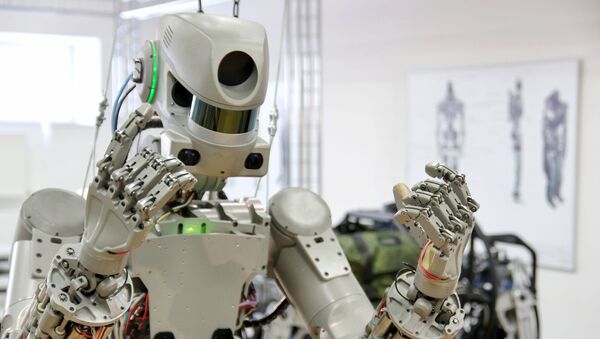This is promising to be a unique flight because for the first time, the robot will sit in the spaceship commander’s chair and not in the cargo compartment, like the American humanoid Robonaut-2 that was delivered to the International Space Station (ISS) several years ago. During the flight, Skybot will comment on what is happening. Aboard the International Space Station, it will perform several tasks under the control of cosmonaut Aleksandr Skvortsov and will be able to communicate with the space crew.
Alexander Bloshenko, science adviser to Roscosmos State Space Corporation’s director general, told Sputnik what the robot will do while aboard the ISS, what sort of things can it talk about, and what awaits the “cyber cosmonaut” after returning to Earth.
Sputnik: What changes have been made to Skybot's design for the flight to the ISS compared to the robot that was developed at the behest of the defence industry's Russian Foundation for Advanced Research Projects (RFARP, a military research agency)?
Alexander Bloshenko: Currently, the modification of the humanoid Skybot F-850 is very different from its “predecessors”. For example, in the new version, the electronic component base, the material of the plastic elements and the control system were changed. All the modifications that had to be done in a short time are closely related to operating conditions and the high requirements for equipment used in the space-flight industry.
Sputnik: Is it possible to call it a “robot” or is it, from a technical point of view, a remote manipulator that resembles a human in shape?
Alexander Bloshenko: Skybot F-850 is fully a “robot”. This is an automatic device that has a predefined programme with elements of artificial intelligence. It can perform tasks such as maintaining equilibrium, decomposing general movements into separate locomotor functions and providing expert support for the crew in an autonomous mode. Additionally, the robot can work in an “avatar” mode, that is, under the full remote control of the operator.
Sputnik: It was reported that the robot will communicate with cosmonauts and comment on the state of the flight in the Soyuz spacecraft. On what topics can it make conversation? Can Skybot make jokes?
Alexander Bloshenko: The humanoid Skybot F-850 can communicate on any topic launched by its interlocutor. Before the launch of the Soyuz-2.1a rocket carrier, it will report on pre-launch preparations, and then while already during the launch and flight, it will be voicing the flight parameters and observed events. At the stage when the spaceship enters orbit, the robot will have to determine the value of the overload and the onset of zero gravity.
Like any person, Skybot F-850 is very sociable, it has a sense of humour. As I have mentioned before, it can support any topic of conversation and answer a variety of questions: from welcoming remarks, continuing with a speech about its creators and ending with the philosophy of space.
Sputnik: How will the robot be powered?
Alexander Bloshenko: The humanoid Skybot F-850 is powered by a set of standard batteries from the Orlan series spacesuit, in which cosmonauts work outside the International Space Station.
Sputnik: What challenges will the robot face while on the ISS? What will it do on board the station?
Alexander Bloshenko: The tasks of Skybot F-850 on board of the International Space Station will be to carry out tests prepared by Russian engineers to assist cosmonauts inside the ISS. During this flight, the robot will work in 'avatar' mode, copying the movements of an operator. If all tests are successful, the next generation of FEDOR humanoids will be tested outside the orbital station. In the future, this will minimise the risk associated with the cosmonaut’s work in outer space, that which they perform while organising repairs on the ISS and other spacecraft.
Sputnik: Are there any concerns that the robot may make careless movements and cause damage to the ISS systems? What security measures are being taken to prevent this from happening?
Alexander Bloshenko: To ensure the safety of the humanoid Skybot F-850 on board the International Space Station, various protection algorithms are used at the control system level. For example, restrictions were introduced on the control action of the operator, on the twitch, acceleration, angular velocity and position of each degree of mobility, as well as all kinds of electronic software “observers” that compare the readings with the mathematical model of the robot.
Sputnik: What will happen to the robot after it returns to Earth? Will it be somehow be further fine-tuned?
Alexander Bloshenko: The decision to finalise the humanoid Skybot F-850 after the flight to the International Space Station will be made based on the results of the processing of data of the current experiment.
Sputnik: When will the robot’s second flight to space happen? Will it go into outer space?
Alexander Bloshenko: The decision on subsequent space flights to low Earth orbit and the release into open space of the Skybot F-850 will be made based on the results of the processing of data of the current experiment. At the moment, there is a draft of a full-fledged programme for further work but it is premature to present it.




